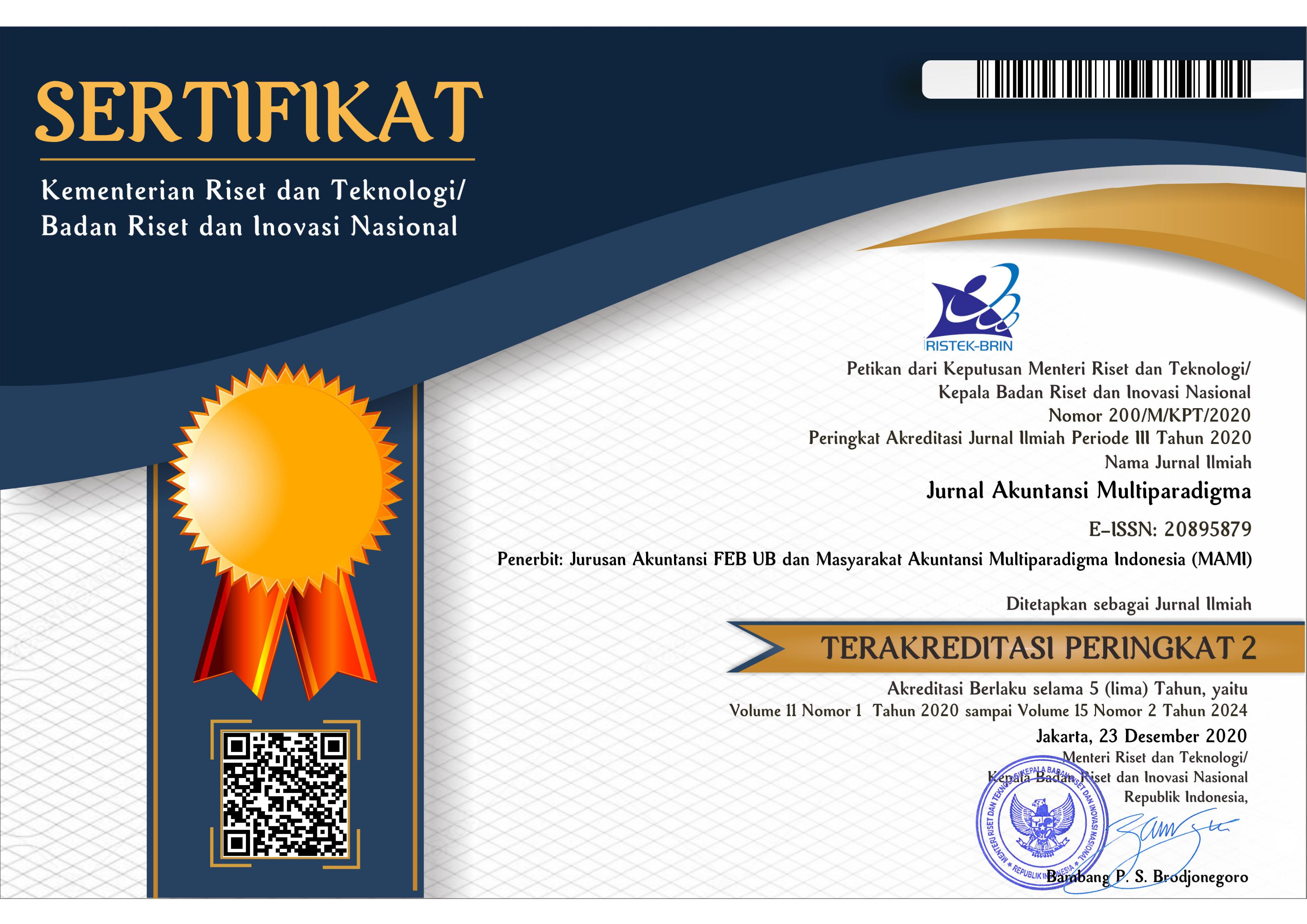HOW DO TAX AVOIDANCE AND PROFITABILITY INFLUENCE A FIRM'S INTRINSIC VALUE?
Abstract
Abstrak - Bagaimana Penghindaran Pajak dan Profitabilitas Mempengaruhi Nilai Intrinsik Perusahaan?
Tujuan Utama – Penelitian bertujuan menelaah bagaimana penghindaran pajak dan profitabilitas mempengaruhi nilai intrinsik perusahaan.
Metode – Penelitian ini menggunakan metode regresi linear berganda. Sampel penelitian ini adalah perusahaan manufaktur selama periode 2016-2020.
Temuan Utama – Profitabilitas perusahaan yang menunjukkan peningkatan laba umumnya dipandang prinsipal mampu memperluas ekspansi investasi sehingga meningkatkan nilai instrinsik. Selain itu, dividen bukan menjadi pilihan utama dalam berinvestasi karena investor lebih memilih bertransaksi untuk jangka pendek. Bagi perusahaan yang mengalami masalah, penurunan tarif pajak menjadi lebih penting.
Implikasi Teori dan Kebijakan – Penelitian ini menunjukkan relevansi teori agensi dalam penentuan nilai intrinsik perusahaan. Pada aspek praktik, nilai intrinsik perusahaan harus dikelola manajemen karena merupakan faktor yang diperhatikan investor sehingga perusahaan perlu mengelola sumber daya, aset, atau modal yang dimiliki untuk menghasilkan keuntungan.
Kebaruan Penelitian - Penelitian ini menambahkan penghindaran pajak untuk mencari penjelasan upaya melakukan perencanaan pajak dan dampaknya.
Abstract - How Do Tax Avoidance and Profitability Influence a Firm's Intrinsic Value?
Main Purpose – The research examines how tax avoidance and profitability affect the firm's intrinsic value.
Method – This study uses multiple linear regression methods. The sample is manufacturing companies during the 2016-2020 period.
Main Findings - The profitability of companies that show an increase in profits is generally viewed by principals as being able to expand investment expansion, thereby increasing intrinsic value. In addition, dividends are not the primary choice in investing because investors prefer short-term transactions. For companies experiencing problems, lowering the tax rate is even more critical.
Theory and Practical Implications – This research demonstrates the relevance of agency theory in determining a company's intrinsic value. On the practical aspect, the firms' intrinsic value must be managed by management because it is a factor that investors pay attention to, so companies need to manage their resources, assets, or capital to generate profits.
Novelty - This research adds tax avoidance to seek explanations for tax planning efforts and their impact.
Keywords
Full Text:
PDFReferences
Abdullah, Hashmi, M. A., Mateen, A., Badshah, Y. A., & Iqbal, M. S. (2022). Does Tax Aggressiveness and Cost of Debt Affect Firm Performance? The Moderating Role of Political Connections. Cogent Economics and Finance, 10(1), 2132645. https://doi.org/10.1080/23322039.2022.2132645
Akbari, F., Salehi, M., & Vlashani, M. A. B. (2019). The Relationship between Tax Avoidance and Firm Value with Income Smoothing: A Comparison between Classical and Bayesian Econometric in Multilevel Models. International Journal of Organizational Analysis, 27(1), 125–148. https://doi.org/10.1108/IJOA-09-2017-1235
Akhtar, S. (2017). Capital Structure of Multinational and Domestic Corporations - A Cross-Country Comparison. Accounting & Finance, 57(2), 319-349. https://doi.org/10.1111/acfi.12135
Amar, A. B., Salah, O. B., & Jarboui, A. (2018). Do Discretionary Accruals Affect Firms’ Corporate Dividend Policy? Evidence from France. Journal of Financial Reporting and Accounting, 16(2), 333-347. https://doi.org/10.1108/jfra-03-2017-0020
Atanda, F. A., & Osemene, F. O. (2020). The Drivers of the Competitiveness of Firms in the Non-Financial Sector: Evidence from Nigeria. Economic Horizons, 22(2), 99–117. https://doi.org/10.5937/ekonhor2002107a
Banerjee, S., & Homroy, S. (2018). Managerial Incentives and Strategic Choices of Firms with Different Ownership Structures. Journal of Corporate Finance, 48, 314-330. https://doi.org/10.1016/j.jcorpfin.2017.10.001
Benjamin, S. J., & Biswas, P. (2019). Board Gender Composition, Dividend Policy and COD: The Implications of CEO Duality. Accounting Research Journal, 32(3), 454–476. https://doi.org/10.1108/ARJ-02-2018-0035
Booth, L., & Zhou, J. (2017). Dividend Policy: A Selective Review of Results from around the World. Global Finance Journal, 34, 1-15. https://doi.org/10.1016/j.gfj.2017.07.002
Bossman, A., Agyei, S. K., Asiamah, O., Agyei, E. A., Arhin, E. Y., & Marfo-Yiadom, E. (2022). Dividend Policy and Performance of Listed Firms on Ghana Stock Exchange. Cogent Economics and Finance, 10(1), 2127220. https://doi.org/10.1080/23322039.2022.2127220
Boubaker, S., Chourou, L., Saadi, S., & Zhong, L. (2019). Does Institutional Investor Horizon Influence US Corporate Financing Decisions? International Review of Financial Analysis, 63, 382–394. https://doi.org/10.1016/j.irfa.2017.09.001
Brown, S., Dutordoir, M., Veld, C., & Veld-Merkoulova, Y. (2019). What is the Role of Institutional Investors in Corporate Capital Structure Decisions? A Survey Analysis. Journal of Corporate Finance, 58, 270-286. https://doi.org/10.1016/j.jcorpfin.2019.05.001
Chandra, C., Edward, Y. R., Sitepu, W. R. B., & Simorangkir, E. N. (2022). Pentingkah Perputaran Aset bagi Nilai Perusahaan? Jurnal Akuntansi Multiparadigma, 13(2), 367–377. https://doi.org/10.21776/ub.jamal.2022.13.2.27
Chatterjee, M., & Bhattacharjee, T. (2020). Ownership Concentration, Innovation and Firm Performance: Empirical Study in Indian Technology SME Context. South Asian Journal of Business Studies, 10(2), 149–170. https://doi.org/10.1108/SAJBS-10-2019-0185
Chauhan, G. S., & Huseynov, F. (2018). Corporate Financing and Target Behavior: New Tests and Evidence. Journal of Corporate Finance, 48, 840-856. https://doi.org/10.1016/j.jcorpfin.2016.10.013
Cook, K. A., Moser, W. J., & Omer, T. C. (2017). Tax Avoidance and Ex Ante Cost of Capital. Journal of Business Finance & Accounting, 44(7-8), 1109-1136. https://doi.org/10.1111/jbfa.12258
Cooper, M., & Nguyen, Q. T. (2020). Multinational Enterprises and Corporate Tax Planning: A Review of Literature and Suggestions for a Future Research Agenda. International Business Review, 29(3), 101692. https://doi.org/10.1016/j.ibusrev.2020.101692
Dao, B. T. T., & Ta, T. D. N. (2020). A Meta-Analysis: Capital Structure and Firm Performance. Journal of Economics and Development, 22(1), 111–129. https://doi.org/10.1108/jed-12-2019-0072
Dixit, B. K., Gupta, N., & Saurabh, S. (2020). Dividend Policy in India: Reconciling Theory and Evidence. Managerial Finance, 46(11), 1437-1453. https://doi.org/10.1108/mf-07-2019-0344
Dyreng, S. D., Hanlon, M., Maydew, E. L., & Thornock, J. R. (2017). Changes in Corporate Effective Tax Rates over the Past 25 Years. Journal of Financial Economics, 124(3), 441. https://doi.org/10.1016/j.jfineco.2017.04.001
Espinosa, C., Jara, M., Maquieira, C., & Vieito, J. P. (2016). Does Corporate Diversification Create Value in Emerging Markets? New Evidence from Chile. Canadian Journal of Administrative Sciences, 35(1), 123-135. https://doi.org/10.1002/cjas.1393
Faisal, F., Majid, M. S., & Sakir, A. (2020). Agency Conflicts, Firm Value, and Monitoring Mechanisms: An Empirical Evidence from Indonesia. Cogent Economics & Finance, 8(1), 1822018. https://doi.org/10.1080/23322039.2020.1822018
Graham, J. R., & Harvey, C. R. (2001). The Theory and Practice of Corporate Finance: Evidence from the Field. Journal of Financial Economics, 60(2–3), 187–243. https://doi.org/10.1016/S0304-405X(01)00044-7
Ha, N. M. M., Anh, P. T., Yue, X. G., & Nam, N. H. P. (2021). The Impact of Tax Avoidance on the Value of Listed Firms in Vietnam. Cogent Business and Management, 8(1), 1930870. https://doi.org/10.1080/23311975.2021.1930870
Hasan, M. M., Lobo, G. J., & Qiu, B. (2021). Organizational Capital, Corporate Tax Avoidance, and Firm Value. Journal of Corporate Finance, 70, 102050. https://doi.org/10.1016/j.jcorpfin.2021.102050
Hauser, R., & Thornton, J. H. (2017). Dividend Policy and Corporate Valuation. Managerial Finance, 43(6), 663–678. https://doi.org/10.1108/MF-05-2015-0157
He, J., Tian, X., Yang, H., & Zuo, L. (2020). Asymmetric Cost Behavior and Dividend Policy. Journal of Accounting Research, 58(4), 989–1021. https://doi.org/10.1111/1475-679X.12328
Isensee, C., Teuteberg, F., Griese, K. M., & Topi, C. (2020). The Relationship between Organizational Culture, Sustainability, and Digitalization in SMEs: A Systematic Review. Journal of Cleaner Production, 275, 122944. https://doi.org/10.1016/j.jclepro.2020.122944
Jacob, M., Rohlfing-Bastian, A., & Sandner, K. (2021). Why Do Not All Firms Engage in Tax Avoidance? Review of Managerial Science, 15(2), 459-495. https://doi.org/10.1007/s11846-019-00346-3
Jensen, C., & Meckling, H. (1976). Theory of the Firm: Managerial Behavior, Agency Costs, and Ownership Structure. Journal of Financial Economics, 3(4), 305–360. https://doi.org/10.1016/0304-405X(76)90026-X
Kamaliah. (2020). Disclosure of Corporate Social Responsibility (CSR) and Its Implications on Company Value as a Result of the Impact of Corporate Governance and Profitability. International Journal of Law and Management, 62(4), 339–354. https://doi.org/10.1108/IJLMA-08-2017-0197
Karim, S., & Ilyas, M. (2021). Foreign Institutional Investors and the Contribution of Cash and Dividend to Firm’s Value. Managerial Finance, 47(3), 310–325. https://doi.org/10.1108/MF-11-2019-0568
Kim, J., Yang, I., Yang, T., & Koveos, P. (2021). The Impact of R&D Intensity, Financial Constraints, and Dividend Payout Policy on Firm Value. Finance Research Letters, 40, 101802. https://doi.org/10.1016/j.frl.2020.101802
Li, L., & Islam, S. Z. (2019). Firm and Industry Specific Determinants of Capital Structure: Evidence from the Australian Market. International Review of Economics & Finance, 59, 425-437. https://doi.org/10.1016/j.iref.2018.10.007
Liao, Y., Huang, P., & Ni, Y. (2022). Convertible Bond Issuance Volume, Capital Structure, and Firm Value. North American Journal of Economics and Finance, 60(151), 101673. https://doi.org/10.1016/j.najef.2022.101673
Lozano, M. B., & Caltabiano, S. (2014). Cross Institutional Cash and Dividend Policies: Focusing on Brazilian Firms. Applied Economics, 47(3), 239-254. https://doi.org/10.1080/00036846.2014.967516
Maradona, A. (2020). Aggressive Reporting Behaviour under the Implementation of Indonesian Accounting Standards. Jurnal Akuntansi Multiparadigma, 11(1), 23-38. https://doi.org/10.21776/ub.jamal.2020.11.1.02
Mehdi, M., Sahut, J., & Teulon, F. (2017). Do Corporate Governance and Ownership Structure Impact Dividend Policy in Emerging Market during Financial Crisis? Journal of Applied Accounting Research, 18(3), 274-297. https://doi.org/10.1108/jaar-07-2014-0079
Moore, R. D. (2020). The Concave Association between Tax Reserves and Equity Value. Journal of the American Taxation Association, 43(1), 107-124. https://doi.org/10.2308/jata-17-109
Mubyarto, N., & Khairiyani. (2019). Kebijakan Investasi, Pendanaan, dan Dividen sebagai Determinan Nilai Perusahaan. Jurnal Akuntansi Multiparadigma, 10(2), 328-341. https://doi.org/10.18202/jamal.2019.08.10019
Nguyen, T. G. (2020). Stock Liquidity and Dividend Policy: Evidence from an Imputation Tax Environment. International Review of Financial Analysis, 72, 101559. https://doi.org/10.1016/j.irfa.2020.101559
Navas, J. F. (2021). Secured Debt, Agency Problems, and the Classic Model of the Firm. The Quarterly Journal of Finance, 11(3), 2150015. https://doi.org/10.1142/s2010139221500154
Ni, J., Chu, L. K., & Li, Q. (2017). Capacity Decisions with Debt Financing: The Effects of Agency Problem. European Journal of Operational Research, 261(3), 1158–1169. https://doi.org/10.1016/j.ejor.2017.02.042
Qi, Y., Roth, L., & Wald, J. (2017). Creditor Protection Laws, Debt Financing, and Corporate Investment Over the Business Cycle. Journal of International Business Studies, 48(4), 477-497. https://doi.org/10.1057/s41267-016-0016-1
Ramli, N. A., Latan, H., & Solovida, G. T. (2019). Determinants of Capital Structure and Firm Financial Performance—A PLS-SEM Approach: Evidence from Malaysia and Indonesia. The Quarterly Review of Economics and Finance, 71, 148-160. https://doi.org/10.1016/j.qref.2018.07.001
Ranajee, R., Pathak, R., & Saxena, A. (2018). To Pay or Not to Pay: What Matters the Most for Dividend Payments? International Journal of Managerial Finance, 14(2), 230-244. https://doi.org/10.1108/ijmf-07-2017-0144
Riccetti, L., Russo, A., & Gallegati, M. (2016). Financialisation and Crisis in an Agent Based Macroeconomic Model. Economic Modelling, 52, 162-172. https://doi.org/10.1016/j.econmod.2014.11.028
Rudyanto, A., & Pirzada, K. (2020). The Role of Sustainability Reporting in Shareholder Perception of Tax Avoidance. Social Responsibility Journal, 17(5), 669–685. https://doi.org/10.1108/SRJ-01-2020-0022
Salehi, M., Mahdavi, N., Dari, S. Z. A., & Tarighi, H. (2019). Association between the Availability of Financial Resources and Working Capital Management with Stock Surplus Returns in Iran. International Journal of Emerging Markets, 14(2), 343-361. https://doi.org/10.1108/ijoem-11-2017-0439
Singla, H. K. (2020). Does VAIC Affect the Profitability and Value of Real Estate and Infrastructure Firms in India? A Panel Data Investigation. Journal of Intellectual Capital, 21(3), 309–331. https://doi.org/10.1108/JIC-03-2019-0053
Stereńczak, S., & Kubiak, J. (2022). Dividend Policy and Stock Liquidity: Lessons from Central and Eastern Europe. Research in International Business and Finance, 62, 101727. https://doi.org/10.1016/j.ribaf.2022.101727
Sumani, S., Roziq, A., & Manurung, D. T. H. (2020). Relevankah Teori Struktur Modal di Indonesia? Jurnal Akuntansi Multiparadigma, 11(2), 373-385. https://doi.org/10.21776/ub.jamal.2020.11.2.22
Taher, F. N. A., & Al-Shboul, M. (2022). Dividend Policy, Its Asymmetric Behavior and Stock Liquidity. Journal of Economic Studies, 50(3), 578–600. https://doi.org/10.1108/JES-10-2021-0513
Thakur, B. P., Kannadhasan, M., Charan, P., & Gupta, C. P. (2019). Corruption and Firm Value: Evidence from Emerging Market Economies. Emerging Markets Finance and Trade, 57(4), 1182-1197. https://doi.org/10.1080/1540496x.2019.1613643
Trihermanto, F., & Nainggolan, Y. A. (2020). Corporate Life Cycle, CSR, and Dividend Policy: Empirical Evidence of Indonesian Listed Firms. Social Responsibility Journal, 16(2), 159–178. https://doi.org/10.1108/SRJ-09-2017-0186
Wahjudi, E. (2020). Factors Affecting Dividend Policy in Manufacturing Companies in Indonesia Stock Exchange. Journal of Management Development, 39(1), 4–17. https://doi.org/10.1108/JMD-07-2018-0211
Wang, S. S., Goh, J. R., Sornette, D., Wang, H., & Yang, E. Y. (2021). Government Support for SMEs in Response to COVID-19: Theoretical Model Using Wang Transform. China Finance Review International, 11(3), 406–433. https://doi.org/10.1108/cfri-05-2021-0088
Wilde, J. H., & Wilson, R. J. (2018). Perspectives on Corporate Tax Planning: Observations from the Past Decade. Journal of the American Taxation Association, 40(2), 63-81. https://doi.org/10.2308/atax-51993
Xu, S., Chen, X., Li, A., & Xia, X. (2020). Disclosure for Whom? Government Involvement, CSR Disclosure and Firm Value. Emerging Markets Review, 44, 100717. https://doi.org/10.1016/j.ememar.2020.100717
Xu, S., & Zheng, K. (2018). Tax Avoidance and Asymmetric Cost Behavior. Journal of Accounting, Auditing & Finance, 35(4), 723-747. https://doi.org/10.1177/0148558x18793757
DOI: http://dx.doi.org/10.21776/ub.jamal.2023.14.1.08
Refbacks
- There are currently no refbacks.
Copyright (c) 2023 Luluk Muhimatul Ifada, Nunung Ghoniyah, Nurcahyono

This work is licensed under a Creative Commons Attribution-NonCommercial 4.0 International License.

















